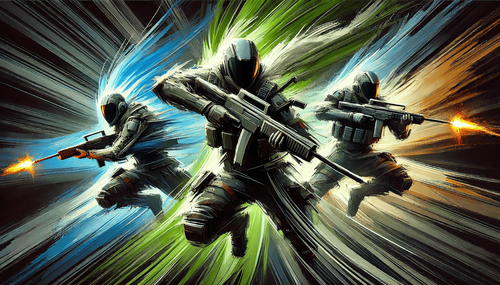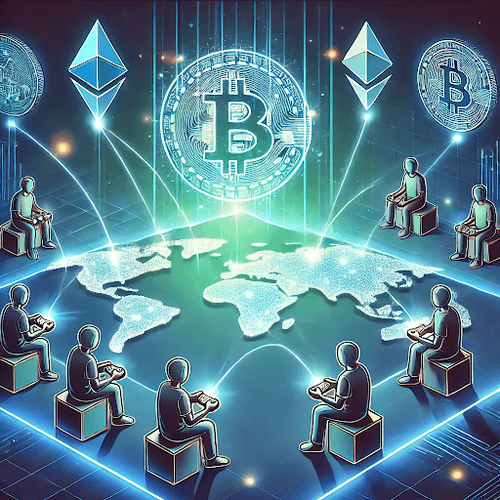The overarching vision for Web3 gaming is to empower players with more control, reward them in proportion to the value they contribute, and to lower the bar so that it’s not just the top 0.1% of players who can make a living through gaming." Tom Fleetham - Zilliqa.
Introduction
The Web3 gaming ecosystem boasts an average of 7.4 million daily unique active wallets (dUAW), accounting for 29% of all decentralized application (dApp) activity as of December 2024. Among the most popular Web3 games driving GameFi adoption are World of Dypians, Seraph: In the Darkness, and Pixels.
As Web3 gaming matures, engagement has grown across a diverse range of genres, with RPGs emerging as a leading category due to their immersive narratives and in-game economies. A 2023 report by Game7 shows that RPGs account for 22% of all gaming activity in the Web3 ecosystem.
Currently, Web3 AAA games represent only 1% of the total Web3 gaming market, but upcoming titles such as Shrapnel, Ubisoft’s Champions Tactics, and Gunzilla’s Off-the-Grid are set to provide players with more immersive, high-production gaming experiences. According to Steam, approximately 71% of its daily users engage with AA or AAA titles.
As a result, leading RPGs like Seraph—which ranks among the top Web3 AAA games—are poised for increased adoption. Since its launch, Seraph players consisting of over 905k unique active wallets (UAW) have created approximately 2.7 million NFT items, with trading volume eclipsing $2.55M across over 6.02M transactions.
This research explores the rising demand for AAA Web3 games and the strategies Web2 gaming studios are adopting to transition into the Web3 ecosystem. It includes a comparative analysis of leading Web3 games, focusing on in-game trading assets and user engagement metrics.
Rise of AAA Games in Web3
AAA games are traditionally recognized for their large budgets (defined as exceeding $25 million), state-of-the-art 3D graphics, and advanced gameplay mechanics. These games are typically developed by large studios such as Ubisoft, Activision Blizzard, Unity, and Konami.
Below, we analyze notable AAA Web3 titles, their features, and factors contributing to their success or failure.
AAA Web3 Titles and their Features
| Game | 3D Graphics | PvP Mode | NFT Integration | Token Economy | Multichain | Daily Unique Active Wallets | NFT Marketcap |
|---|---|---|---|---|---|---|---|
| Illuvium | Yes | Yes | Yes | Yes | No | 2 | $785K |
| Seraph | Yes | Yes | Yes | Yes | Yes | 200.2K | $1.5M |
| Shrapnel | Yes | Yes | No | Yes | No | 75 | $520.2K |
| My Crypto Heroes | No | Yes | Yes | Yes | Yes | 69 | N/A |
| World of Dypians | Yes | Yes | No | Yes | Yes | 911.9K | N/A |
| GRIT | Yes | Yes | Yes | No | No | N/A | $8.4K |
| Off the Grid | Yes | Yes | No | Yes | No | N/A | N/A |
| Deaddrop | Yes | Yes | Yes | No | No | N/A | N/A |
| Champions Tactics | No | Yes | No | No | No | N/A | $388.8K |
| The Machine Arena | Yes | Yes | Yes | No | No | 110K | $18.7K |
Source: DappRadar, AAA Games in Web3 Note: Daily Unique Active Wallets are counted by any wallet interacting or performing a transaction with a game's smart contracts over the past 24 hours.
A recurring challenge among AAA Web3 games, even those boasting high-quality visuals and engaging gameplay, is sustaining player retention. Titles like Illuvium and My Crypto Heroes, despite their innovation, continue to struggle in keeping players engaged within the Web3 ecosystem. This reveals a broader issue: innovation and eye-catching blockchain features alone are not enough to sustain long-term player involvement.
In contrast, Seraph distinguishes itself by creating a player-driven economy with streamlined on-chain interactions. Leveraging its team’s prior success in Web2 gaming, Seraph has integrated a seamless in-game wallet, allowing players to jump directly into gameplay without relying on third-party applications. This streamlined user experience reduces friction and makes it easier for new players to engage with the game. Additionally, Seraph incentivizes participation through NFTs, enabling players to collect, trade, and use in-game assets—fostering a sense of ownership that strengthens long-term engagement.
Ultimately, the key to success in Web3 gaming lies in offering a compelling gaming experience first, while using blockchain as a tool to enhance ownership and player investment rather than as a marketing buzzword.
The Shift from Web2 to Web3 Gaming
The traditional Web2 gaming market is valued at $4.3 trillion, while the Web3 gaming market is currently estimated at $18 billion, representing only 0.4% of its Web2 counterpart. However, projections suggest that Web3 gaming could reach $301.5 billion by 2030, meaning the sector is expected to grow more than 16.75 times its current size. This explosive growth underscores the immense potential of the Web3 gaming space and the unique opportunity it offers for developers and studios to enter a rapidly expanding market.
According to a 2023 report by Coingecko, 29 of the world's 40 largest gaming companies are actively exploring Web3 technologies. Of these, seven are developing Web3 games in-house, while others are investing in blockchain gaming projects or hiring for blockchain-related roles.

Source: Coingecko
Notable companies launching their own Blockchain Game include Take-Two Interactive, Nexon, Bandai Namco, Konami, Krafton, Square Enix, and Ubisoft. Interestingly the other 22 Web2 gaming companies have chosen to engage with Web3 indirectly, focusing on investments and infrastructure. For instance, Microsoft has made strategic investments in WeMade, a blockchain game production leader, while Sony launched Sonieum, an Ethereum layer-2 network aimed at supporting Web3 applications, including gaming.
Significant Trends Among Web2 Companies Transitioning into Web3 Games
We analyzed several Web2 companies making the transition into Web3. Our analysis identified five major trends among Web2 companies entering the Web3 gaming space. These include NFT adoption, token-driven economies, and leveraging legacy intellectual property.
Web2 Company Web3 Game Features
| Company | Launched NFT Collection | Token-driven Economy | Adopting Legacy IPs | Merging AI/Creator Tools | Developing new Blockchain Infrastructure |
|---|---|---|---|---|---|
| Take-Two Interactive | Yes | Yes | No | No | No |
| Nexon | No | No | Yes | No | No |
| Bandai Namco | Yes | No | No | Yes | No |
| Konami | Yes | No | Yes | No | No |
| Krafton | No | Yes | No | Yes | No |
| Square Enix | Yes | Yes | Yes | No | No |
| Ubisoft | Yes | Yes | Yes | No | No |
| Sony | No | No | No | No | Yes |
Source: AAA Games in Web3- DappRadar
Here are key trends we observed:
- NFT Adoption (5/8 companies)
Five of the companies, including Take-Two, Bandai Namco, and Square Enix, have launched NFT collections, highlighting the industry's move toward digital asset ownership.
- Token-Driven Economies (4/8 companies)
Take-Two, Square Enix, Ubisoft, and Krafton have incorporated token-based economies, enabling players to trade and own in-game assets, signaling a shift towards decentralized economies.
- Leveraging Legacy IPs (4/8 companies)
Nexon, Konami, Square Enix, and Ubisoft are integrating blockchain into existing franchises, using established brand recognition to attract players into Web3 gaming.
- Merging AI & Creator Tools (2/8 companies)
Bandai Namco and Krafton are leading in the integration of AI and user-generated content, suggesting a growing trend of blending blockchain with emerging technologies to enhance interactivity.
- Developing New Blockchain Infrastructure (1/8 companies)
Using existing blockchain infrastructure is the dominant strategy, with 7 out of 8 companies opting for established networks. Sony stands as the exception, building its own blockchain to address Web3 gaming scalability challenges.
As evidenced by the trends above, many more Web2 companies are incorporating blockchain, NFTs, and AI to create more immersive player experiences and new revenue models. This marks a broader shift from centralized gaming ecosystems toward decentralized, player-owned economies, where users have greater control over their digital assets and in-game experiences.
How well are Web2 companies fairing in Web3
2024 marked a significant year for traditional gaming companies transitioning into Web3 games. Highly anticipated titles like Off The Grid and Ubisoft’s Champion Tactics launched in early access, while the Sony Group launched its Layer 2 chain “Soneium” on Testnet.
Key performance insights from Web2 games transitioning into Web3:
- Gunzilla’s Off the Grid: Achieved strong success with over 12.4M unique active wallets, 304.4M transactions, and 2.5M daily transactions. The game attracted 150,000 Twitch viewers at peak and benefited from a multi-platform launch on PlayStation, Xbox, and PC, increasing mainstream exposure.
- Ubisoft's Champions Tactics: Minted 75,000 NFTs on the Oasys network. However, the game faced setbacks due to a critical matchmaking bug and a lack of diverse gameplay modes, leading to low engagement despite initial interest. Only 2,700 NFTs were actively traded, with prices ranging from $6 to $63,000.
- Sony's Soneium: Recorded over 14M unique active wallets and 47M transactions during its testnet phase. The platform launched its mainnet on January 14, 2025, and has onboarded multiple projects with plans to enhance NFT capabilities through a new Fan Marketing Platform launching in February.
Overall, while a majority of Web2 companies like Sony have found early success in Web3 games, there is a need for ongoing innovation to address challenges related to technical issues, market reception, and finding a balance between integrating blockchain without alienating traditional gamers.
Growing Partnerships Among Web3 Gaming Companies
In recent years, partnerships between established Web3 companies have intensified, fostering synergies that accelerate the growth of Web3 gaming. Immutable partnered with GRAMPUS CWC to bring established games to Web3, including the Web3 adaptation of Cooking Adventure.
Additionally, Animoca Brands has led a new $20M funding round for The Sandbox, aimed at enhancing the platform's multiplayer systems and supporting its mobile expansion, planned for 2025. These strategic developments highlight the ongoing efforts by metaverse-based games to integrate social interactions and gameplay customization, appealing to both casual players and professional creators alike.
Seraph has partnered with opBNB, leveraging its low median gas fees ($0.0001) and high transaction throughput (97 TPS) to optimize in-game transactions.
Leading Genres in Web3 Games
As Web3 gaming evolves, certain genres have gained significant traction, demonstrating varying levels of player engagement. A 2023 report by Game7 identified RPGs as the dominant genre, accounting for 22% of all Web3 games, followed closely by action games at 17%.
Further analysis of the top 15 Web3 games on DappRadar by unique active wallets reinforces the growing popularity of RPGs.
Web3 Genre Breakdown

Source: Web3 Games per Genre - DappRadar
RPG games dominate the Web3 gaming space, representing 43% of the total UAWs across gaming genres analyzed, with Seraph alone contributing 18.5% of the total 2.8M UAWs. This highlights the genre's strong player appeal, driven by character progression, immersive storylines, and in-game asset ownership, which foster deep, long-term engagement.
Adventure games account for 10.5% of UAWs, led by popular titles like Pixels and Axie Infinity. Emerging genres such as Metaverse (14.5%), Strategy (4.4%), and Move-to-Earn (3.5%) further illustrate the growing demand for interactive and player-driven experiences.
With blockchain enhancing engagement and ownership, Web3 games are fostering vibrant ecosystems that empower players to feel more invested in their in-game achievements and economies.
In-game Assets Trading Comparisons
NFT and token trading volumes are key indicators of Web3 gaming adoption, reflecting player engagement and asset liquidity. Projects with high trading volumes often reflect robust in-game economies, large active player bases, and strong interest in digital asset ownership. Below, we compare key metrics such as market cap and trading volume for NFT and token assets across three leading GameFi projects: Seraph, Axie Infinity, and Illuvium.
NFT and Token Market Performance (Launch vs. Current)
| NFT Market Cap | NFT Trading Volume | Market Cap (FDV) | Trading Volume | |||
|---|---|---|---|---|---|---|
| Current | Current | Launch | Current | Launch | Current | |
| Seraph | $1.5M | $927K | $353.6M | $139.3M | $129.2M | $91.5M |
| Axie Infinity (AXS) | $35.6M | $435K | $39.2M | $854.8M | $37.6M | $273.9M |
| Illuvium | $785K | $32K | $89.8M | $135.4M | $79.9M | $214.3M |
Sources: Actpass, DappRadar, Axie Infinity, Coingecko, Cryptoslam;
Note: Launch refers to the first 7 days post-token or NFT release, current represents a 7 day span from 3/5/25 to 3/12/25
Key Findings
The data reveals how these projects have performed differently in both NFT and token markets. While all three games experienced varying degrees of growth in certain areas, their overall success was influenced by factors such as sustained player engagement, digital asset liquidity, and token economy strategies. Here is what we find:
- NFT Trading Performance:
Seraph leads in NFT trading volume, reaching $927K, reinforcing its strong player interest and secondary market activity. Meanwhile Axie Infinity’s NFT trading volume sits at $435K, its ecosystem is smaller than past years, but has room for expansion as player engagement grows.
- NFT Market Cap:
Axie Infinity holds the largest NFT market cap at $35.6M, reflecting its well-established presence. Seraph’s $1.5M NFT market cap signals an emerging asset economy within its ecosystem, demonstrating growth potential in the Web3 gaming space. Additionally, multiple Seraph NFTs were burnt to redeem $SERAPH after TGE, thus lowering NFT supply and market cap.
- Token Market Cap Expansion:
Seraph, a recent entrant, holds a $139.3M token market cap, reflecting strong early adoption and investor confidence. In contrast, Axie Infinity and Illuvium have had years to develop post-Token Generation Event (TGE), allowing them to build long-term valuations of $854.8M and $135.4M, respectively. Seraph’s early traction suggests potential for continued growth as its ecosystem expands.
- Token Trading Volume:
With a $91.5M trading volume, Seraph has maintained steady market participation, signaling consistent liquidity. Illuvium saw an increase to $214.3M, reflecting rising adoption, while Axie Infinity remains the most liquid at $223.9M.
Early momentum for Seraph in both token market cap and trading volume highlights its ability to attract engagement despite being a newer entrant. Axie Infinity continues to set benchmarks in liquidity and valuation, while Illuvium has strengthened its market presence.
Conclusion
The Web3 gaming landscape is undergoing a transformative shift, driven by the integration of decentralized technologies and the increasing participation of leading Web2 gaming companies. The growth in unique active wallets (UAWs) across RPG titles like Seraph, alongside the rise of AAA games such as Off the Grid, underscores the strong appeal of blockchain-based gaming experiences that offer asset ownership, community-driven economies, and immersive storytelling.
For Web2 studios transitioning to Web3, the strategies adopted—ranging from blockchain integration to the incorporation of NFTs and decentralized finance (DeFi) elements—are key to unlocking new revenue streams and engaging players in unprecedented ways. As companies like Ubisoft, Sony, and Take-Two Interactive lead the charge, their successful adaptation will serve as a benchmark for future Web3 gaming endeavors.
Seraph exemplifies how seamless wallet integration, player-driven economies, and active community engagement contribute to sustained success in Web3 gaming. With its rapid user growth and high NFT trading volume, Seraph exemplifies the potential of Web3 games to not only attract large audiences but also to retain them through meaningful engagement and ownership incentives.




